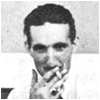4/4/1902 - 14/3/1982
Record updated 04-Apr-07
Robert Eberan von Eberhorst was one of the world's premiere racing car design theorists. He was Head of Experimental Work in the racing department of Auto Union until 1941. After the war he worked for Porsche before moving to England with ERA and Aston Martin. He return to Germany in 1953 and re-joined Auto Union.

Professor Dr Ing Eberan-Eberhorst was born Robert Eberan von Eberhorst on 23 October 1902 in Vienna, but the family shortened its name when the nobility was abolished in Austria in 1918. He studied at the Vienna Technical University until in 1927 he joined the Institute for Automotive Engineering at Dresden Technical University as an assistant. In 1933 Dr Ferdinand Porsche persuaded him to join Auto Union as Head of Experimental Work in the racing department.
The design of the Auto Union Silver Arrow Type D (1938/1939) was his work. With a swept volume of three litres in accordance with the then F1, the supercharged V12 rear-mounted engine could develop 480 bhp which obviously contributed to the Grand Prix victories of Tazio Nuvolari and Hermann Müller. Eberhorst was heavily involved in the initial testing of each new racing car, developing an on-board recording instrument to plot parameters such as car speed, engine speed, gear change and braking points. He gained his doctorate in 1940 and from 1941 was appointed to a full professorship at Dresden Technical University.
During WW2 he was involved in the design of the Tiger tank and initial testing of the V1/V2 rockets. In 1947, in an old sawmill in Gmünd, Austria, Ferdinand Porsche’s son Ferry and Eberhorst started work on project 356, which evolved into the famous Porsche 356 sports car.
After WW2 the Italian Piero Dusio decided to build racing cars, bringing in the engineers Dante Giacosa and Giovonni Savonuzzi from Fiat and Piero Taruffi to manage the racing team. When it was time to attack the GP circuits, Carlo Abarth and Robert Eberan-Eberhorst were employed. This project went sour when the designers proposed a flat 12 four-cam engine with the possibility of supercharging and even four-wheel drive plus Eberhorst’s usual requirements for proper jigs, test-beds and tooling; his view was that races are better lost on the test-beds then they can be won on the tracks.
Eberhorst was by now recognised as one of the world's premiere racing car design theorists, so in 1949 he moved to Dunstable, where he worked for ERA on the Jowett Jupiter chassis, and then in 1950 to Aston Martin to design a pure sports-racing car, the DB3, his brief being to produce a car that would be quick enough to give the 2.6-litre straight six a chance of outright wins. Whilst at Aston Martin Eberhorst published an article in the Automobile Engineer entitled “Roll Angles”. This theoretical study followed Maurice Olley’s paper “Road Manners of the Modern Car” and established ex-Rolls-Royce engineer Olley and Eberhorst as two of only a handful of engineers capable of mathematically defining the essential factors in car handling. Eberhorst’s contribution was to show how the several constants in Olley’s complex equations could be established experimentally.
In 1953 Eberhorst returned to Germany as General Manager for Technical Development at a reviving Auto Union. In 1956 he moved to the Battelle Institute in Frankfurt as Head of Mechanical Engineering and four years later he took over responsibility for the Combustion Engines and Automotive Engineering Institute at Vienna University. He retired from there in 1965 although continuing to author important technical papers. He died in 1982 in his native Vienna.
wikipedia.org